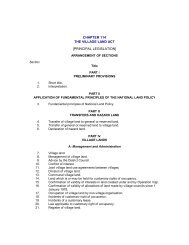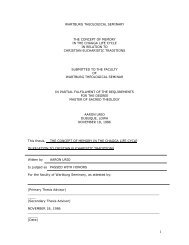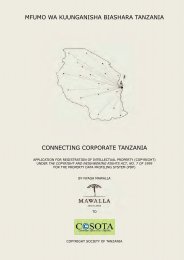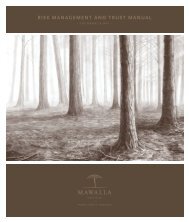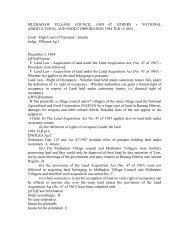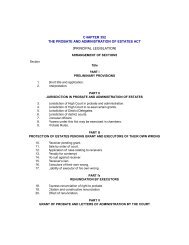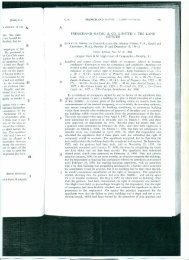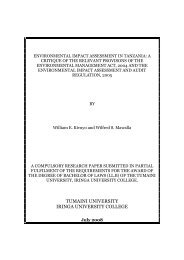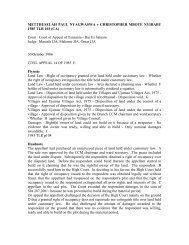- Page 1 and 2: A COMPILATION OF CASES OF JUDICIAL
- Page 3 and 4: 4.3 Assistant Imports controller v
- Page 6 and 7: appropriate respondent, i.e, if in
- Page 8 and 9: the individual complaining of breac
- Page 10 and 11: of the Constitution that there shou
- Page 12 and 13: y one judge of the High Court. Desp
- Page 16 and 17: “ Section 3 debars the individual
- Page 18 and 19: action in tort would have lain agai
- Page 20 and 21: is a claim against the state for wh
- Page 22 and 23: decision of Scott J., the Court of
- Page 24 and 25: “the provisions of this Chapter f
- Page 26 and 27: True, it admitted actions against t
- Page 28 and 29: I have seen this particular phrase
- Page 30 and 31: conclusion, have shied away from th
- Page 32 and 33: 2. JURISDICTION AND OUSTER CLAUSES2
- Page 34 and 35: It is by no means obvious, at least
- Page 36 and 37: ight of action against the state of
- Page 38 and 39: “It is hereby recognized and decl
- Page 40 and 41: They were (1) that the Height Court
- Page 42 and 43: infallible but no one that is fair.
- Page 44 and 45: upon the reference in the subsectio
- Page 46 and 47: his right. In so far as section 3 (
- Page 48 and 49: into effect. That is the extent of
- Page 50 and 51: CHAPTER 1“THE RECOGNITION AND PRO
- Page 52 and 53: the invalidity of the order of comm
- Page 54 and 55: unlawful under existing law and the
- Page 56 and 57: creates new rights and freedoms whi
- Page 58 and 59: The following additional cases were
- Page 60 and 61: 2.8 OTTU v Attorney General & Anor.
- Page 62 and 63: prudently concealed the constitutio
- Page 64 and 65:
an expressly enacted condition is l
- Page 66 and 67:
most of their intended meaning. Rep
- Page 68 and 69:
though there were numerous conflict
- Page 70 and 71:
of this technique. The error of the
- Page 72 and 73:
Lord Reid observed, there are no de
- Page 74 and 75:
Tanzania, for declaration that the
- Page 76 and 77:
Sass Salula, state attorney, appeal
- Page 78 and 79:
2. since the respondents have a cou
- Page 80 and 81:
Is the trial judge correct? We have
- Page 82 and 83:
case to case, but it is doubtful th
- Page 84 and 85:
compensation depends on the circums
- Page 86 and 87:
odies. It is basic structure of a d
- Page 88 and 89:
land rights order, 1987 extinguishe
- Page 90 and 91:
those listed villages were declared
- Page 92 and 93:
IN THE COURT OF APPEAL OF TANZANIAA
- Page 94 and 95:
as in terms of Government Proceedin
- Page 96 and 97:
interlocutory relief orders. While
- Page 98 and 99:
serious matter and article 26 of it
- Page 100 and 101:
The respondents Council, Mr. Werema
- Page 102 and 103:
emptied possible negative legal con
- Page 104 and 105:
the operation of the statute must n
- Page 106 and 107:
ANDANJELINA OJARE ……………
- Page 108 and 109:
holding, in process, section 148 (5
- Page 110 and 111:
Act. The complainant on whose behal
- Page 112 and 113:
(a) regulating procedure for instit
- Page 114 and 115:
CA/86/35IN THE COURT OF APPEAL OF T
- Page 116 and 117:
The present appellants urged a numb
- Page 118 and 119:
The basis of the High Court decisio
- Page 120 and 121:
irrationality and procedural improp
- Page 122 and 123:
“There is plenty of authority to
- Page 124 and 125:
25 (1970) E.A 487(K)26 Cap. 49027 H
- Page 126 and 127:
But not all Commonwealth countries
- Page 128 and 129:
These clauses in their can only rel
- Page 130 and 131:
On my part I would not like to be i
- Page 132 and 133:
efore them the written proposals fr
- Page 134 and 135:
53 (1979) 1 W.L.R. 140154 (1982) 3
- Page 136 and 137:
The Assistant Price Commissioner it
- Page 138 and 139:
considered it wrongful and institut
- Page 140 and 141:
y a licid judgment. Upon all this M
- Page 142 and 143:
judgment for the plaintiff against
- Page 144 and 145:
facto an act of misconduct by a mem
- Page 146 and 147:
It could be used as a ploy. The imp
- Page 148 and 149:
substantial lapse of time before th
- Page 150 and 151:
of the United Kingdom financial mar
- Page 152 and 153:
“Acts o misconduct may consist of
- Page 154 and 155:
Monopolies and Commission. On 24 Se
- Page 156 and 157:
financial adviser with its client i
- Page 158 and 159:
The executive has also discussed th
- Page 160 and 161:
companies respectively. 2. As regar
- Page 162 and 163:
The earlier history of the write of
- Page 164 and 165:
In reaching my conclusion that the
- Page 166 and 167:
Consistently with its character as
- Page 168 and 169:
unconditional and they did so procu
- Page 170 and 171:
The formalism thus introduced into
- Page 172 and 173:
the source of its power, and (ii) t
- Page 174 and 175:
So once again one comes back to wha
- Page 176 and 177:
However, it seems clear that, wheth
- Page 178 and 179:
But the difficulties confronting th
- Page 180 and 181:
THE REGISTERED TRUSTEES OF CHAMA CH
- Page 182 and 183:
11. That on the 1 st day of July, 1
- Page 184 and 185:
Africa by the proviso to Article 15
- Page 186 and 187:
treatment. If floodgate it entails,
- Page 188 and 189:
propositions? To answer that questi
- Page 190 and 191:
“That it is the exclusive right o
- Page 192 and 193:
AT DODOMACIVIL CASE NO. 5 OF 1993RE
- Page 194 and 195:
In para 5 the petitioner claims tha
- Page 196 and 197:
provisions of the Constitution prov
- Page 198 and 199:
these provisions are ordinary and l
- Page 200 and 201:
desirable. This is illustrated by t
- Page 202 and 203:
appointment by the President of the
- Page 204 and 205:
private motion on the desirability
- Page 206 and 207:
(2) enacts into our Contribution th
- Page 208 and 209:
(b) It advocated the breaking up of
- Page 210 and 211:
his birth and are therefore prior t
- Page 212 and 213:
(1) subjected to the other provisio
- Page 214 and 215:
country. It seems also that the Dar
- Page 216 and 217:
contravenes, is contravening or is
- Page 218 and 219:
The Constitution is basic or paramo
- Page 220 and 221:
I would not wish to believe that by
- Page 222 and 223:
decline to determine whether there
- Page 224 and 225:
The position as I see it, is now th
- Page 226 and 227:
full exercise of the fundamental ri
- Page 228 and 229:
The founders of our Union could eas
- Page 230 and 231:
IN THE HIGH COURT OF TANZANIAAT DAR
- Page 232 and 233:
stated that the applicants would no
- Page 234 and 235:
Indeed, it is learned Senior State
- Page 236 and 237:
law. The present application falls
- Page 238 and 239:
Now, what really is the purpose and
- Page 240 and 241:
THE MINISTER FOR ENERGY & MINERALS
- Page 242 and 243:
In my judgment Underhill and Anothe
- Page 244 and 245:
The appellant, Mecaiana Establishme
- Page 246 and 247:
course, there is the exception wher
- Page 248 and 249:
application, the judge dismissed th
- Page 250 and 251:
That since this was not done, the R
- Page 252 and 253:
the expiry of 180 days, there was n
- Page 254 and 255:
IN THE COURT OF APPEAL OF TANZANIAA
- Page 256 and 257:
and held that the High Court had po
- Page 258 and 259:
The sub-section requires that the A
- Page 260 and 261:
In a farther attempt by Mr. Mussa t
- Page 262 and 263:
in a real sense, a party to the cas
- Page 264 and 265:
The available evidence, therefore a
- Page 266 and 267:
L.M/ MFAILAJUSTICE OF APPEALI certi
- Page 268 and 269:
proceedings Act, 1967 which require
- Page 270 and 271:
ministerial fiat is taken away;. He
- Page 272 and 273:
denied the right files suit, but al
- Page 274 and 275:
The European Court of Human Rights
- Page 276 and 277:
Constitutionalism in Africa: A New
- Page 278 and 279:
That is a sufficient and reasonable
- Page 280 and 281:
An anachronism in a democratic stat
- Page 282 and 283:
exactly what happened in the case o
- Page 284 and 285:
sought but was withheld The require
- Page 286 and 287:
Considering that the Government pro
- Page 288 and 289:
is without prejudice to any other r
- Page 290 and 291:
Thus consistent with that approach.
- Page 292 and 293:
13.(1) all person are equal before
- Page 294 and 295:
5 GROUNDS1. Amri Juma & 15 others v
- Page 296 and 297:
It seems to me that that was not wh
- Page 298 and 299:
that at the trial the plaintiff wou
- Page 300 and 301:
Ethicon LTD (Ethicon) restraining t
- Page 302 and 303:
Russell LJ is apparent from an earl
- Page 304 and 305:
c. against injury by violation of h
- Page 306 and 307:
pay them there would be no reason t
- Page 308 and 309:
trial owing to the damaging effect
- Page 310 and 311:
What transpired at the high court i
- Page 312 and 313:
that a request for its extension ha
- Page 314 and 315:
The Supreme Court of Kenya dismisse
- Page 316 and 317:
C.A. FARMERS BUS v. TRANSOPRT LICEN
- Page 318 and 319:
Civil practice and procedure- Tempo
- Page 320 and 321:
compel the applicant General Manage
- Page 322 and 323:
H.W. GOLCHER V. MANAGER (MCM) (Main
- Page 324 and 325:
IN THE HIGH COURT OF TANZANIAAT DAR
- Page 326 and 327:
8. That on 15 th May 1980 the appli
- Page 328 and 329:
ecord into the High court that they
- Page 330 and 331:
I cannot but accept the proposition
- Page 332 and 333:
Glidewilll J. grated the applicant
- Page 334 and 335:
Foreign and commonwealth Affairs da
- Page 336 and 337:
in the following terms: Such regula
- Page 338 and 339:
On 6 August 1984 the Court of Apica
- Page 340 and 341:
to exist; in others the interest is
- Page 342 and 343:
identified or even adumbrated in th
- Page 344 and 345:
member of the home civil service up
- Page 346 and 347:
administrative tribunal to observe
- Page 348 and 349:
een represented the reason for such
- Page 350 and 351:
unions concerned either at a nation
- Page 352 and 353:
The facts of the case may be stated
- Page 354 and 355:
general council of JUWATA As alread
- Page 356 and 357:
The second respondent’s counter-c
- Page 358 and 359:
1. THE PRINCIPAL SECRETARY (ESTABS)
- Page 360 and 361:
The appellant by then had already w
- Page 362 and 363:
of the appellant ought to be quashe
- Page 364 and 365:
As we have already said the appella
- Page 366 and 367:
The appellant went further to point
- Page 368 and 369:
that the learned Chief justice as w
- Page 370 and 371:
question is whether the removal fro
- Page 372 and 373:
Judge ought to be removed from offi
- Page 374 and 375:
The appellant then concluded by ref
- Page 376 and 377:
The appellant also raised the issue
- Page 378 and 379:
agree with the learned judge and th
- Page 380 and 381:
that the two Annexes A and D.1 talk
- Page 382 and 383:
of advice and asserted that there w
- Page 384 and 385:
appellant in response to his repeat
- Page 386 and 387:
The learned judge said that there w
- Page 388 and 389:
ut that they might have thought tha
- Page 390 and 391:
demean him but will also undermine
- Page 392 and 393:
Secretary wrote to the appellant An
- Page 394 and 395:
SYVESUER .210 ... APPICATIONSVorsus
- Page 396 and 397:
it is necessary not only that a cor
- Page 398 and 399:
commissioner to give reasons for th
- Page 400 and 401:
was not given reasons he was left w
- Page 402 and 403:
qualifications is entrusted to the
- Page 404 and 405:
his decision is a sufficient exclus
- Page 406 and 407:
in Broom’s Legal maxims under the
- Page 408 and 409:
IT.VERSUS1. THE DISTRICT CONTISSION
- Page 410 and 411:
applied for an order of Temporary I
- Page 412 and 413:
No. of 1987 and for the District Co
- Page 414 and 415:
Mohamed Ally Athumani P.W.l, testif
- Page 416 and 417:
kwa hiari yako mwenyewe Endapo utas
- Page 418 and 419:
Adam HusseinS.L.P 85 Tel 470Songea1
- Page 420 and 421:
issued to Wagunya and Wasomali His
- Page 422 and 423:
een produced and marked exhibit P.1
- Page 424 and 425:
No time was give to Moamed omari to
- Page 426 and 427:
expiring on the 30 th April 1987 Hi
- Page 428 and 429:
The District Commissioner Songea Di
- Page 430 and 431:
case. In entertaining these applica
- Page 432 and 433:
and the towncouncil Songea and the
- Page 434 and 435:
1985, 1986 and 1987 a said to have
- Page 436 and 437:
stage where one find people with vi
- Page 438 and 439:
Commissioners of songea district an
- Page 440 and 441:
In Misc. Civil case No. 2 of 1987 t
- Page 442 and 443:
The Court held that the respondent
- Page 444 and 445:
individuals the courts ought to exe
- Page 446 and 447:
Mr. Kakoti the respondents solicito
- Page 448 and 449:
say that it is not give to any cour
- Page 450 and 451:
RULINGThe power of the president of
- Page 452 and 453:
Now the said plaintiff has filed a
- Page 454 and 455:
another remedy against that decisio
- Page 456 and 457:
In that case the revecation of righ
- Page 458 and 459:
‘ These courts have the authority
- Page 460 and 461:
as to whether the President was rig
- Page 462 and 463:
In 1973 the applicant, Moses J. Mwa
- Page 464 and 465:
On 21 February, and before the Atto
- Page 466 and 467:
It should be observed at the outs t
- Page 468 and 469:
are four ways under the Constitutio
- Page 470 and 471:
Forces of the United Republic and i
- Page 472 and 473:
unable to agree with the applicant
- Page 474 and 475:
E.A.304, at p.313. On such facts eq
- Page 476 and 477:
There can be no stoppel against the
- Page 478 and 479:
emoval of a judge from. Office for
- Page 480 and 481:
K.S.K. LUCKKINGIBA,JUDGE7/4/1992.I
- Page 482 and 483:
addressed to him by the Acting Prin
- Page 484 and 485:
ank of Prison officer, Grade III an
- Page 486 and 487:
or under the provisions of the Tang
- Page 488 and 489:
longer hold in may be signified thr
- Page 490 and 491:
Songoro urged me to hold that the P
- Page 492 and 493:
interest, where removal is concerne
- Page 494 and 495:
may be effected. Neither what is st
- Page 496 and 497:
in law. As I understand the law, if
- Page 498 and 499:
11. Vidhyadhar Chavda v Director of
- Page 500 and 501:
RULINGKYANDO, J.This is an applicat
- Page 502 and 503:
I am not certain of the sufficiency
- Page 504 and 505:
is good practice, and whether the m
- Page 506 and 507:
Administrative Law” also point ou
- Page 508 and 509:
TANZANIA LAW REPORTS (1987) T.L.R.A
- Page 510 and 511:
Be that as it may, I hold as did my
- Page 512 and 513:
applicants with full benefits. That
- Page 514 and 515:
situations, namely (a) where the pa
- Page 516 and 517:
applicant, through its learned coun
- Page 518 and 519:
consequence thereof, the decision o
- Page 520 and 521:
jurisdiction to try the suit, by vi
- Page 522 and 523:
way of certiorari and mandarms whic
- Page 524 and 525:
Orders of certiorari against the tw
- Page 526 and 527:
The high court dismissed the applic
- Page 528 and 529:
(1970) E.A. 523. It is true that th
- Page 530 and 531:
of the Rent Restriction Act 1984, h
- Page 532 and 533:
Parliament. But he has never purpor
- Page 534 and 535:
All the grounds or appeal having fa
- Page 536 and 537:
court (1992) 1 QB 270) delivered on
- Page 538 and 539:
Cases referred to in opinionsAdams
- Page 540 and 541:
this case Mr. Kenneth Baker, in his
- Page 542 and 543:
proceedings brought against him, in
- Page 544 and 545:
judgments of Simon Brown I and Lord
- Page 546 and 547:
detention can only aggravane these
- Page 548 and 549:
Paris at 7. 45 pm. The plane on whi
- Page 550 and 551:
Having obtained the order the solic
- Page 552 and 553:
subject to Treasury Solicitors (sic
- Page 554 and 555:
were made for his return from Niger
- Page 556 and 557:
contempt arises in this context thi
- Page 558 and 559:
action rather than to decline to ta
- Page 560 and 561:
applicants was that it was in the c
- Page 562 and 563:
have reconsidered the dicta in two
- Page 564 and 565:
from Prime Minister down to a const
- Page 566 and 567:
order or direction that the alleged
- Page 568 and 569:
Raleigh v Goschen was applied in Hu
- Page 570 and 571:
Are not made parties to the bill as
- Page 572 and 573:
However, before raring to that Act
- Page 574 and 575:
property, but may in lie thereof ma
- Page 576 and 577:
have been obtained in proceedings a
- Page 578 and 579:
the law officers on behalf of the m
- Page 580 and 581:
circumstances attach importance to
- Page 582 and 583:
Prior to the introduction of judici
- Page 584 and 585:
Accordingly one approaches this ca
- Page 586 and 587:
ecent developments, illustrated by
- Page 588 and 589:
emedies of mandamus and prohibition
- Page 590 and 591:
the 1981 Act should be given a rest
- Page 592 and 593:
Supreme Court (Northern Ireland) in
- Page 594 and 595:
operate as a stay of the proceeding
- Page 596 and 597:
prerogative proceedings against off
- Page 598 and 599:
set aside the order though his deci
- Page 600 and 601:
(heareinafter rerred to as the Boar
- Page 602 and 603:
contradiction, I think, that it is
- Page 604 and 605:
“Finality is a good thing but jus
- Page 606 and 607:
East Africa 377. In that case the l
- Page 608 and 609:
And the remarks of COIREN, Lj. (as
- Page 610 and 611:
principles. With considerable amoun
- Page 612 and 613:
Before I decide what orders, if any
- Page 614 and 615:
Delivered at Songea in open court t
- Page 616 and 617:
held that the decision by the Manag
- Page 618 and 619:
impugned decision, thenb the said d
- Page 620 and 621:
574. He was just claiming damages f
- Page 622 and 623:
There is the other question, how do
- Page 624 and 625:
Lord alkin said in a famous passage
- Page 626 and 627:
We must not betray the confidence b
- Page 628 and 629:
number of days during which the emp
- Page 630 and 631:
PARTMAN GARMENTS v TANZANIA (MWAKAS
- Page 632 and 633:
(1) Re H.H. (1967) 2 Q.B 617.(2) Pa
- Page 634 and 635:
Garments Industries Limited by the
- Page 636 and 637:
The learned trial judge in his judg
- Page 638 and 639:
10 - (2) Notwithstanding the provis
- Page 640 and 641:
Our second observation on the above
- Page 642 and 643:
the President under subsection (2)
- Page 644 and 645:
made by the President revoking the
- Page 646 and 647:
IN THE HIGH COURT OF TANZANIAAT DAR
- Page 648 and 649:
examinations. Howver, on 2 May 1984
- Page 650 and 651:
visited with deterrent or exemplary
- Page 652 and 653:
committee. With regard to the IFM S
- Page 654 and 655:
the Executive committee was created
- Page 656 and 657:
occasions to conduct the interviews
- Page 658 and 659:
A. That is not true.Q. is Angela yo
- Page 660 and 661:
..(in the chamber summons the word
- Page 662 and 663:
acting in the course as their dutie
- Page 664 and 665:
Every assuming that the words “ci
- Page 666 and 667:
e in a position to make an order wh
- Page 668 and 669:
53. The position is accurately set




